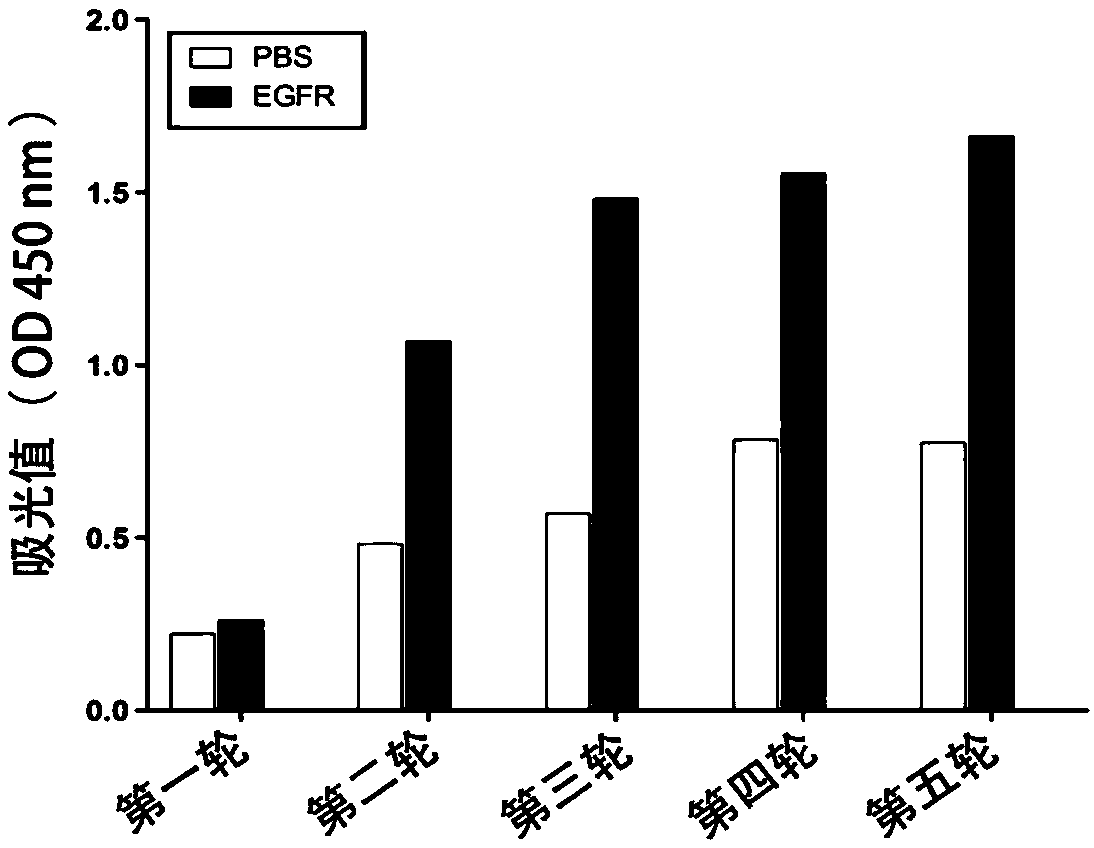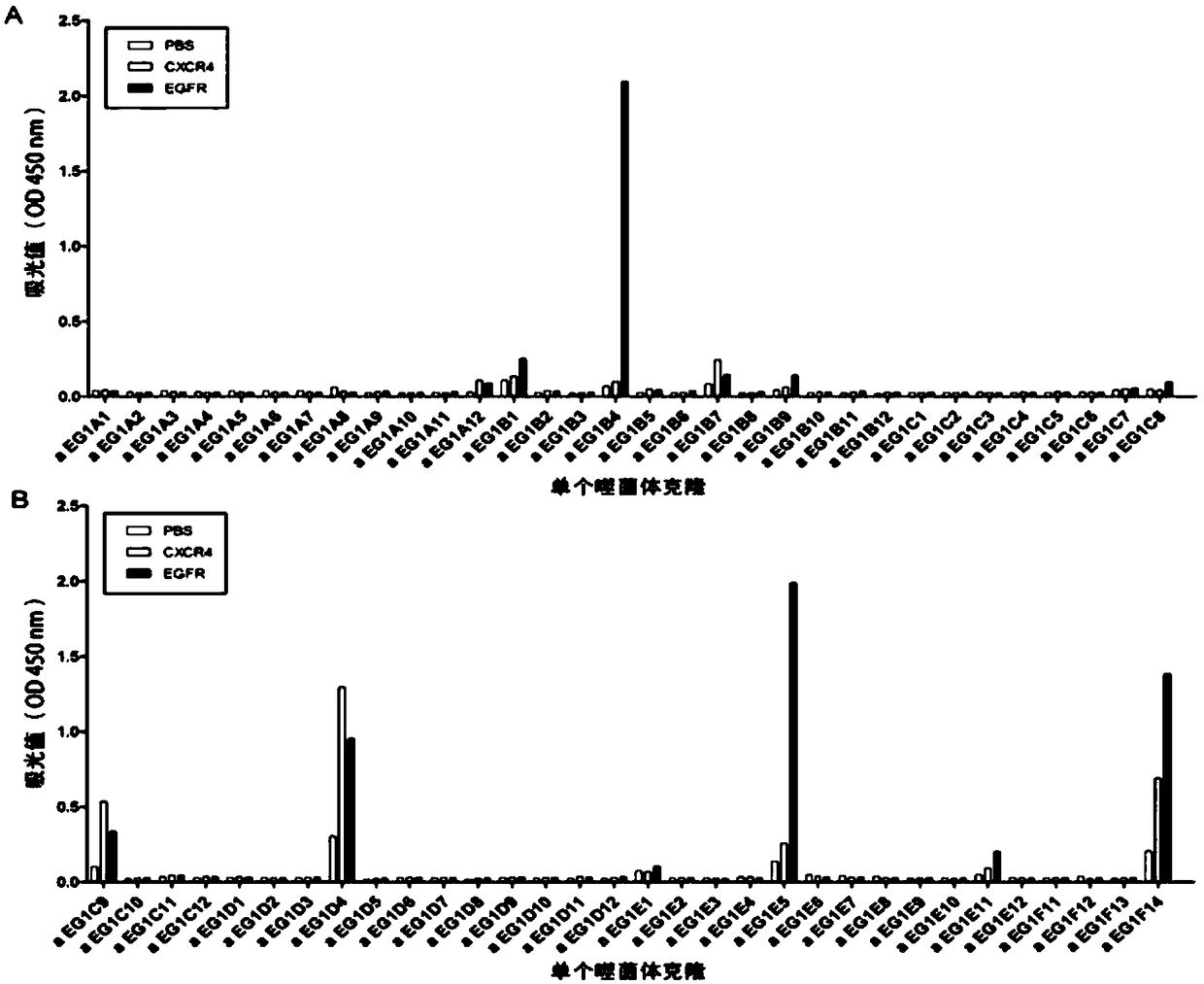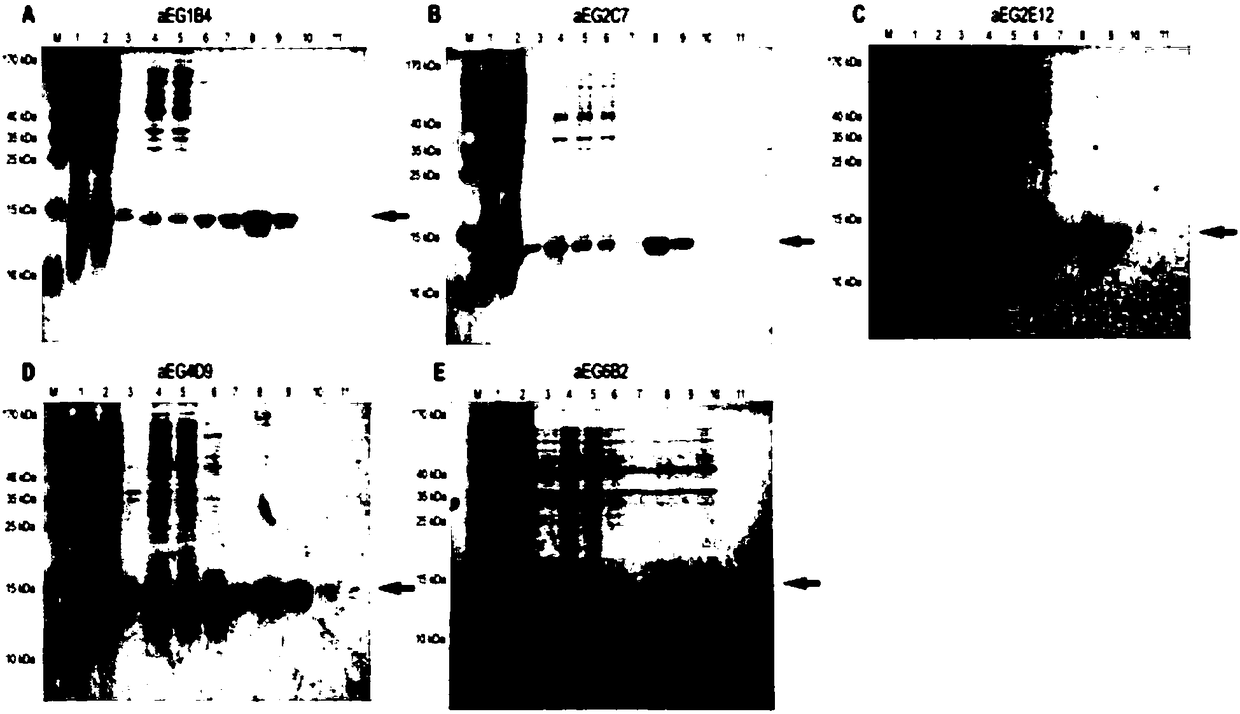Anti-human EGFR (epidermal growth factor receptor) nano antibody and application thereof
A nanobody and antibody technology, applied in the field of anti-human EGFR nanobody, can solve the problems of ineffective removal of small lesions, poor penetration ability, large molecular weight, etc., and achieve the effects of easy transformation, good stability, and application promotion.
- Summary
- Abstract
- Description
- Claims
- Application Information
AI Technical Summary
Problems solved by technology
Method used
Image
Examples
Embodiment 1
[0047] Example 1 preparation of helper phage
[0048] (1) Take out the glycerol-preserved TG1 Escherichia coli clone strain from the -80°C refrigerator, spread it on a TYE non-resistant plate using the four-section method, and incubate it upside down at 37°C for 13 hours.
[0049] (2) Pick a TG1 monoclonal strain from the plate and inoculate it into 5 mL of 2×TY non-resistance liquid medium, and culture it at 37° C. and 230 rpm for 13 hours.
[0050] (3) Transfer the TG1 bacterial solution to 5mL 2×TY non-resistant liquid medium at a volume ratio of 1:100, and culture it at 37°C and 230rpm for 2h (bacterial solution OD 600 = around 0.5).
[0051] (4) Take 200 μL TG1 bacterial solution (OD 600 =0.5 or so) into a 1.5mL centrifuge tube, add 10μL of KM13 helper phage (1×10 13 pfu / mL), placed in preheated 37°C water bath for 30min.
[0052] (5) Prepare soft agar, let it cool to about 40°C, pour the TG1 bacterial solution treated in step (4), mix, and then pour the pre-prepared ...
Embodiment 2
[0057] Example 2 Amplification of Phage Nanobody Library
[0058] (1) Thaw the TG1 bacteria containing the antibody plasmid (i.e., the human nanobody phage library, SourceBioscience, London, UK) on ice, and transfer it to 500mL 2×TY liquid medium (containing 0.1% ampicillin by mass volume ratio) and mass volume ratio of 1% glucose), 37 ° C, 230rpm shaker culture 2.5h (OD 600 =0.5), and then add 2×10 12 The helper phage, 37 ℃ water bath for 30min.
[0059] (2) Divide the bacterial solution into 250 mL / bottle, centrifuge at 3200 g for 10 min, remove the supernatant, and use 500 mL of 2×TY medium (containing 0.1% ampicillin by mass volume ratio and 0.05% kanamycin by mass volume ratio) The pellet was resuspended, and cultured with shaking at 25°C and 220rpm for 20h.
[0060] (3) The bacterial liquid was centrifuged at 3200 g for 20 min, and the supernatant was collected, and the phage was purified by the same method as steps (8)-(9) in Example 1, and the prepared library phage...
Embodiment 3
[0062] Example 3 Screening Nanobodies Against EGFR Fragments from a Phage Nanobody Library
[0063] (1) Screening of anti-EGFR nanobody phage
[0064] 1) Coat the EGFR polypeptide (purchased from Shanghai Botai Biological Co., Ltd., with the amino acid sequence shown in SEQ ID NO.15) in the immunotube (nunc) (the first round: 0.1 mg / mL; the second and third rounds : 0.05mg / mL; the fourth and fifth rounds: 0.025mg / mL;), set the PBS (control) tube. overnight at 4°C.
[0065] 2) Pour out the coating solution, wash each tube with 4.5mL PBS three times (after adding the liquid each time, discard without stopping), add 4.5mL of BSA blocking solution with a concentration of 2% by mass volume ratio to each tube, and place at room temperature 2h.
[0066] 3) Pour off the BSA blocking solution, and wash each tube with 4.5mL PBS three times (after adding the liquid each time, discard it directly without stopping).
[0067] 4) Add 4mL to each tube containing 5×10 12 2% BSA solution o...
PUM
| Property | Measurement | Unit |
|---|---|---|
| Titer | aaaaa | aaaaa |
Abstract
Description
Claims
Application Information
 Login to View More
Login to View More - R&D
- Intellectual Property
- Life Sciences
- Materials
- Tech Scout
- Unparalleled Data Quality
- Higher Quality Content
- 60% Fewer Hallucinations
Browse by: Latest US Patents, China's latest patents, Technical Efficacy Thesaurus, Application Domain, Technology Topic, Popular Technical Reports.
© 2025 PatSnap. All rights reserved.Legal|Privacy policy|Modern Slavery Act Transparency Statement|Sitemap|About US| Contact US: help@patsnap.com



